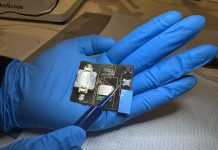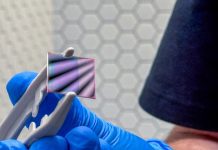
Engineers at RMIT University have developed a small device that can detect hand movements, store visual memories, and process information in a way that closely mimics the human brain.
Led by Professor Sumeet Walia, the team says the new ‘neuromorphic’ device could one day enhance applications in autonomous vehicles, advanced robotics, and human-machine interaction by enabling real-time visual processing without relying on traditional computing systems.
“Neuromorphic vision systems are designed to use similar analogue processing to our brains, which can greatly reduce the amount of energy needed to perform complex visual tasks compared with digital technologies used today,” said Walia, director of the RMIT Centre for Opto-electronic Materials and Sensors (COMAS).
The device, composed of a metal compound called molybdenum disulfide (MoS?), captures light and processes it as electrical signals, mimicking how neurons transmit information in the human brain.
The innovation combines neuromorphic materials with advanced signal processing techniques, with work led by Professor Akram Al-Hourani, Deputy Director of COMAS.
In experiments, the device demonstrated the ability to detect changes in hand motion using edge detection – a method that avoids processing every frame, thereby conserving power and data resources.
Once detected, these changes were stored as memories, similar to how the brain records visual experiences.
“This proof-of-concept device mimics the human eye’s ability to capture light and the brain’s ability to process that visual information, enabling it to sense a change in the environment instantly and make memories without the need for using huge amounts of data and energy,” Walia said.
PhD researcher Thiha Aung, the study’s first author, added that the team successfully demonstrated that the atomically thin MoS? could replicate leaky integrate-and-fire (LIF) neuron behaviour – considered a foundational element of spiking neural networks.
The team’s previous work focused on still image processing in the ultraviolet spectrum, but the latest study extended this functionality to the visible spectrum. In both cases, the memory within the devices can be reset, allowing them to be reused for new tasks.
RMIT has filed a provisional patent for the technology, and the research has been published in Advanced Materials Technologies.
The work is supported by a recent Linkage Infrastructure, Equipment and Facilities (LIEF) grant from the Australian Research Council, which will help scale the single-pixel prototype to a larger array of devices.
“Neuromorphic vision in these applications… could detect changes in a scene almost instantly, without the need to process lots of data, enabling a much faster response that could save lives,” Walia said.
Al-Hourani added that more natural human-robot interactions could be enabled by such systems due to their ability to recognise and respond to human behaviour with minimal delay.
Looking ahead, the team aims to integrate their analogue technology with conventional digital electronics to create hybrid systems suited for specific real-world applications.
They are also exploring alternative materials to expand the device’s functionality into infrared, with potential uses in environmental monitoring and public safety.
“We see our work as complementary to traditional computing, rather than a replacement,” Walia said. “Conventional systems excel at many tasks, while our neuromorphic technology offers advantages for visual processing where energy efficiency and real-time operation are critical.”



















